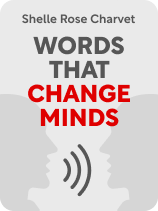

This article is an excerpt from the Shortform book guide to "Words That Change Minds" by Shelle Rose Charvet. Shortform has the world's best summaries and analyses of books you should be reading.
Like this article? Sign up for a free trial here.
What mental habits do you have? How do they impact your behaviors and choices? How can you leverage what you know about someone else’s mental habits?
Communication and influencing language expert Shelle Rose Charvet argues that, if you learn how another person thinks, you can consciously match their frame of reference and speak in a language they understand. Then, you can influence them more effectively.
Read more to learn about the psychological basis for Charvet’s assertion: neuro-linguistic programming theory.
Leveraging Neuro-Linguistic Programming Theory
Charvet explains that her system of analyzing the way different people think and communicate is based on a field of psychological study called neuro-linguistic programming theory, or NLP theory. According to NLP theory, as people learn and grow, they “program” themselves with specific mental habits that determine how they judge situations and make decisions.
These relatively fixed mental habits cause people to consistently repeat the same behavioral patterns. So, if you understand someone’s mental habits, you can predict how they’ll act. For example, if someone habitually focuses on the details of a task rather than the big picture of what they’re trying to accomplish, they may fixate on a to-do list item at work that doesn’t really matter.
(Shortform note: Motivational speaker Tony Robbins also bases his philosophy on neuro-linguistic programming. In his book Unlimited Power, Robbins emphasizes that you have the power to “reprogram” your mental habits by adopting a new set of beliefs, intentions, and values. Robbins asserts that, because mental habits determine how you act, changing them gives you the power to change your habitual behaviors and gain control over your life.)
How to Identify Mental Habits
How do you figure out what someone’s mental habits are? According to NLP, after someone develops certain mental habits, they reveal these habits in the language they use to describe their thought processes and the world around them. For example, someone who habitually focuses on details will give an abundance of concrete information when describing a situation.
Charvet contends that, by listening closely to the language someone uses when speaking, you can identify 14 mental habits that tell you everything you need to know to communicate effectively with that person.
(Shortform note: Charvet asserts that a person’s mental habits determine the specific language they use, but there’s some evidence that this process also works in reverse: The language we use shapes our mental habits. For instance, people who speak some Australian languages develop the mental habit of directional awareness—they can tell you which way is north or south at any time, even in total darkness. This is because directions are built into their language—the words they use to describe locations specify compass points like “northeast” and “southwest,” rather than relative terms like “left” or “right.” Speaking in these terms pushes their brains to devote more attention to directional awareness.)
Charvet notes a key difference between this theory and other personality profiles (like the Myers-Briggs Type Indicator or the Big Five personality traits): This framework acknowledges that the same person utilizes different mental habits in different situations. Identifying a mental habit someone uses doesn’t mean you’ve uncovered a core, unchanging part of their personality—you’ve just identified a situational behavior pattern that they’ll likely repeat in a similar situation.
(Shortform note: As Charvet acknowledges in the book, social scientist Rodger Bailey was the first to delineate this set of 14 mental habits—six explaining the “why” behind a person’s actions and eight explaining the “how.” He drew these habits from a broader list by social scientist Leslie Cameron-Bandler of 60 mental habits she calls “metaprograms.” Presumably, Bailey chose these habits from the greater list because they’re the most relevant and practical in a workplace setting. If you can motivate someone to work and let them work in the ways that suit them best, you don’t need to know any more about them to produce value.)
| Is Personality Entirely Situational? In The Lucifer Effect, Philip Zimbardo further refutes the idea that people have fixed personality traits you can identify with a test or capture in a profile. He contends that personality as we know it is almost entirely malleable—in two different situations, you could behave like two totally different people. To discern which identity to adopt in a given situation, you look for identity cues: aspects of the environment that signify what behavior is currently appropriate. According to Zimbardo, this means that if you’re surrounded by enough powerful identity cues, you could adopt a totally new identity. In some cases, you could end up committing cruel, immoral acts that you normally would never dream of. For example, when Zimbardo dressed undergraduate Stanford students as guards in a simulated prison and surrounded them with identity cues that made this situation feel real, they were willing to inflict cruel, degrading punishments on fellow students playing the role of inmates. |
Mirror Mental Habits to Communicate Well
Once you’ve identified someone’s mental habits, you need to mirror their linguistic style to effectively communicate with and influence them, according to Charvet. Speaking in the terms people naturally use to think and communicate will make you seem more rational and convincing.
In the workplace, mirroring other people’s language will help you convince them that your ideas are valuable, avoid conflicts rooted in misunderstanding or perceived disrespect, and encourage the people you’re managing or coaching to be more receptive to your advice. For example, if you notice that someone you’re mentoring talks a lot about how their work makes others feel, you could influence them to stop being late for meetings by mirroring that kind of language: “The team and I get a bit irritated whenever we have to wait for you to get here.”
(Shortform note: In The Charisma Myth, Olivia Fox Cabane recommends not only mirroring your conversation partner’s linguistic style but also their gestures and body language. She contends that this subconsciously signals familiarity and warmth in the other person’s mind, making you more likable. While Charvet’s strategy is primarily focused on helping you communicate on a mental level, Cabane’s strategy helps you connect on an emotional level. Cabane’s advice will likely be equally helpful in the workplace—if your coworkers like you as a person, they’ll give more credence to your ideas, be less combative, and accept more of your advice.)

———End of Preview———
Like what you just read? Read the rest of the world's best book summary and analysis of Shelle Rose Charvet's "Words That Change Minds" at Shortform.
Here's what you'll find in our full Words That Change Minds summary:
- Why it's sometimes hard to understand what others are trying to say
- The 14 kinds of mental habits that explain how people think
- How to understand others better and build positive relationships






